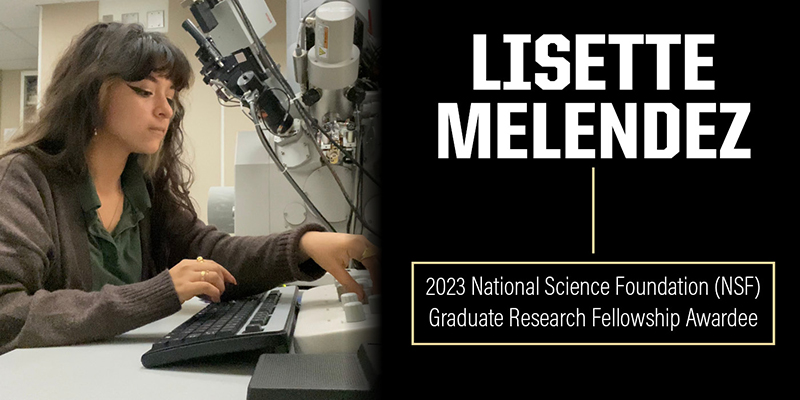Space weathering and asteroid return sample research earns Lisette Melendez an NSF Graduate Research Fellowship
04-07-2023

One of the first graduate students in the world to be able to work with asteroid samples currently headed back to Earth, Lisette Melendez, PhD student with the Department of Earth, Atmospheric and Planetary Sciences (EAPS), has earned a highly competitive National Science Foundation (NSF) Graduate Research Fellowship (GRFP). They study the effects of space weathering and is currently are working with grains returned from asteroid Ryugu by the Japan Aerospace Exploration Agency's Hayabusa2 spacecraft.
Their research focuses on the study of space weathering - namely, micrometeorite bombardment and solar wind irradiation - on asteroidal surfaces. Asteroids are airless bodies, so they do not have the same protective atmosphere as on Earth, leaving their surfaces susceptible to changes in their microstructural, chemical, and spectral properties. Melendez specifically work with grains returned from asteroid Ryugu by the Japan Aerospace Exploration Agency's Hayabusa2 spacecraft. Hayabusa2 returned ~5 g of material from Ryugu's surface.
“I study particles smaller than 1 millimeter to gain insight on large-scale processes occurring across Ryugu,” explains Melendez. “In order to study such small features, I look at the grains using electron microscopes both here at Purdue and at NASA's Johnson Space Center's Astromaterials Research and Exploration Science Division. Every day I'm in the lab I'm in awe that I get to work directly with samples from an asteroid! As I continue with my project, I'm going to expand my research to samples collected from asteroid Bennu, which are anticipated to return to Earth later this very year on NASA's OSIRIS-REx mission. I'll be one of the first graduate students in the world to work with these samples, and I'm incredibly grateful to working with the preeminent expert on space weathering across the solar system!”
According to the NSF, the program supports fellowships for outstanding graduate students who are pursuing full-time, research-based masters and doctoral degrees in science, technology, engineering or math or STEM education. The fellowship provides three years of support over a five-year fellowship period to help with the costs of education.
“For me, the NSF GRFP is the culmination of all of the effort that my supportive community has poured into me,” says Melendez. “From the very beginning, with my mother, always making sure there were books on my shelf, to the many mentors I've gained throughout my research experiences across the University of South Florida, NASA, and the Smithsonian National Museum of Natural History, and to my current advisor Dr. Michelle Thompson, Assistant Professor of Purdue EAPS. When taking on an undergraduate researcher, it's easy to just hand out tasks to be completed. But I'm grateful that the mentors I've had took the extra time to prepare me professionally and helped me feel like I belonged in science. They never made me feel like I had to compromise on any part of my identities as a queer Latine in order to be a good scientist. This research award, to me, represents the importance of fostering aspiring scientists to create a brighter future and culture within the scientific community.”
The application process is stringent for this this highly sought-after fellowship. Future graduate students who might be interested in obtaining an NSF GRFP can learn about the application process here.
“The application process was completed online through the application portal, where we had to submit transcripts, three letters of recommendation, and the bulk of the application, which are the two-page research and three-page personal statements,” Melendez says. “The due date is in late October! We prepared for this application in our Intro to Graduate Studies Seminar, where I received a lot of helpful feedback from my fellow graduate students.”
About the Department of Earth, Atmospheric, and Planetary Sciences at Purdue University
The Department of Earth, Atmospheric, and Planetary Sciences (EAPS) combines four of Purdue’s most interdisciplinary programs: Geology & Geophysics, Environmental Sciences, Atmospheric Sciences, and Planetary Sciences. EAPS conducts world-class research, educates undergraduate and graduate students, and provides our college, university, state and country with the information necessary to understand the world and universe around us. Our research is globally recognized, our students are highly valued by graduate schools, employers, and our alumni continue to make significant contributions in academia, industry, and federal and state government.
Writer: Cheryl Pierce, Communications Specialist
Photo provided by Lisette Melendez